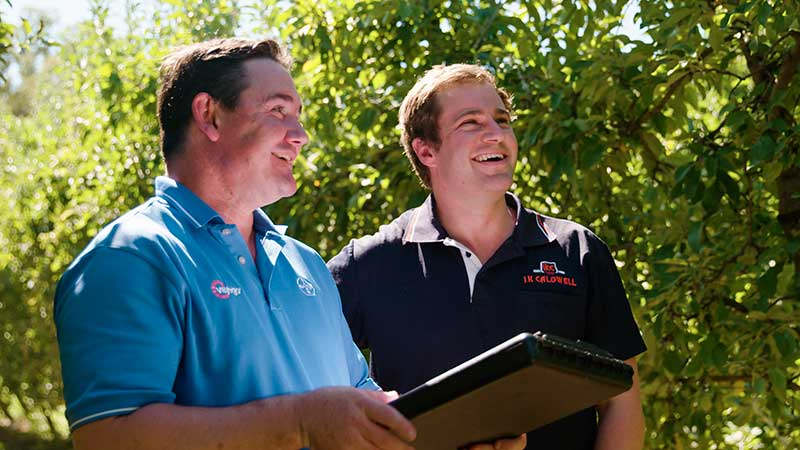New chemistry was used last season by apple growers in Victoria’s Goulburn Valley to tackle significant pests, including the damaging codling moth.
The insecticide, Vayego® from Bayer, not only delivers a high level of efficacy, but also covers a broad spectrum of pests, which is key to driving efficiency for growers.
Pest registration
Vayego, containing the active ingredient tetraniliprole, a Group 28 insecticide, is new to the Australian market.
It is registered in pome fruit, stone fruit, and almonds to control pests including codling moth, light brown apple moth, oriental fruit moth, carpophilus beetle, garden weevil, Fuller’s rose weevil and apple weevil.
As Troy Mulcahy, Bayer Market Development Agronomist in Horticulture, explains, while it’s unusual for Group 28 chemistry to be so broad spectrum, it’s not the only benefit of Vayego.
Efficacy
“The first thing to know about Vayego is it’s got fantastic efficacy and when we compare it to all the other diamides, we see it as best in class chemistry that’s new for the Australian market,” Troy explains.
“Also, as we would expect with Group 28 products, Vayego has a very friendly IPM profile, so when we look at protecting our beneficial species and particularly beneficial mites, Vayego is a really nice fit for that situation.”
Trials
Bayer has been trialling Vayego in Australia over a number of years, including the last two seasons at MJ Hall & Sons, near Mooroopna in Victoria.
In 2021 a trial was conducted at the property to assess the Group 28 diamide products available to industry in a side-by-side replicated trial targeting first-generation codling moth.
“Overall about a quarter of the fruit was damaged in areas that weren’t sprayed at all, which indicates there was a very high level of pressure at the trial site,” Troy explains.
“Vayego was the outstanding treatment in the trial on two fronts, resulting in both the least amount of total damage, and also the least amount of codling moth entries in the fruit. So, when we talk about breaking the life cycle of codling moth, that’s a really significant part.”
Commercial application
The team at MJ Hall & Sons, having seen two years of trial results on their own property, decided to escalate their use of Vayego in 2021, becoming one of the first operations in Australia to use it commercially—and with good reason.
“Codling moth has a major impact in apples and pears here. If left untreated, you can nearly have 100 per cent crop loss,” says I K Caldwell’s Rob Salter, who provides agronomic advice to MJ Hall & Sons.
“This is our first commercial year with Vayego and the results have been really promising, particularly when targeted at that first-generation codling moth.
“Vayego is probably the best Group 28 at the moment from what I’ve seen. The fruit damage we’ve seen this year in blocks that have had Vayego has been minimal, there’s certainly been a lot less stings in apples and pears this season in those blocks.
“That first-generation is critical with codling moth, and if you’ve got a really strong product up first like Vayego, it makes the rest of the season a lot easier.”
Cleaner fruit
With the aim of growers being to reduce overall damage from pests, and produce as clean a fruit as possible, the results of Vayego are a real boost.
“From the work we’ve done with MJ Hall & Sons, we know that Vayego has reduced the amount of damage on the fruit, so from a commercial perspective and a grower’s perspective, that means more marketable fruit,” comments Troy Mulcahy.
Flexible application timing
Tetraniliprole affects all life stages of the codling moth; from adults, through to eggs, through to the larvae. This means increased flexibility around application timing for growers.
“When Vayego is sprayed into crops, and the adults come in contact with tetraniliprole, the product will basically interrupt the codling moth’s orientation skills, reducing the amount of eggs laid, and the fertility of those eggs,” Troy explains.
“If an egg is laid down on fruit and then Vayego is applied, we know we get good control. If Vayego is applied and then an egg is laid on top of that fruit, over a long period of time within our spray interval, then we have a good level of control also.”
“From the adult, to the egg, to the larvae, there are multiple ways to control that pest, and if we particularly do that early in the season, we see the most benefits. It gives farmers a little extra flexibility, particularly around application timing.”
Quick acting
Vayego also provides flexibility in that it works extremely quickly from application to control, as well as delivering long residual control, a point also tested in the trial work by Bayer.
“In the trial we stretched out the spray intervals, so we could really test the residual efficacy of all the products, and again Vayego stood up as the best product,” says Troy.
Easy handling
Being an SC formulation (liquid), handling Vayego is quite easy. The product has also proven to be highly compatible, providing even more flexibility to add multiple products in the tank at any one time. As Rob Salter explains, the feedback from growers has been positive.
“We always welcome new chemistry and particularly improved formulations, and a product like Vayego, being a liquid, is very easy to apply, the pack sizes are very grower-friendly, and compatibility wise, it seems very good” he says.
Find out more about Vayego
See this article in Tree Fruit Oct 2021




















